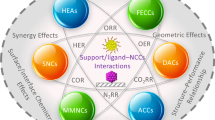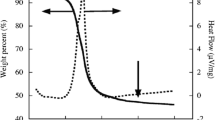Abstract
The most common method for preparation of catalytically active free-standing hybrid material (CAFH) is that supporting material is formed and subsequent catalytic agent deposited on its surface. But it remains challenging to agilely prepare CAFH with different shape and size. We employ a facile process combined with defect-induced electroless nickel plating and selective laser sintering (SLS) forming to fabricate CAFH. Results manifested CH3COOH-etched treatment resulted in the formation of defect (amorphous structure, amide group and hole) on the Nylon 12 (PA12) surface, which would induce electroless Ni plating. The mechanism of the electroless plating is the destruction of the structure of [C6H5O73−-Ni] ligand around defect; subsequently, the reduction of the REDOX barrier. The following laser sintering of the plated PA12 powder could fabricate CAFH with an irregular network. There are two stages during the SLS process: balling of particle and formation of sintered neck. The combination of the structural stability, high surface area and recyclability gives a CAFH with demonstrated catalytic property. CAFH is agile to prepare, easy for quick-to-assemble material and realizable in CAFH shape design. The new technology possesses vast exploration and application value.








Similar content being viewed by others
References
A.P. Yu, Z.W. Chen, R. Maric et al., Electrochemical supercapacitors for energy storage and delivery: advanced materials, technologies and applications. Appl. Energy 153, 1–2 (2015)
M. Elimelech, W.A. Phillip, The future of seawater desalination: energy, technology, and the environment. Science 333, 712–717 (2011)
C.H. Park, H. Yun, H. Yang et al., Fluorescent block copolymer-MoS2 nanocomposites for real-time photothermal heating and imaging. Adv. Funct. Mater. 27, 1604403 (2017)
A.S. Mukasyan, A.S. Rogachev, Combustion synthesis: mechanically induced nanostructured materials. J. Mater. Sci. 52, 11826–11833 (2017)
S. Ravula, C. Zhang, J.B. Essner et al., Ionic liquid-assisted synthesis of nanoscale (MoS2)x(SnO2)1–x on reduced graphene oxide for the electrocatalytic hydrogen evolution reaction. ACS Appl. Mater. Interface 9, 8065–8074 (2017)
Y. Liu, B. Yan, D.A. Winkler et al., Competitive inhibition mechanism of acetylcholinesterase without catalytic active site interaction: study on functionalized C60 nanoparticles via in vitro and in silico Assays. ACS Appl. Mater. Interfaces 9, 18626–18638 (2017)
A. Muhammad, S. Manzar, M. Muhammad et al., Synthesis, characterization, and photoelectrochemical catalytic studies of a water table zinc ased metal-organic framework. Chemsuschem 11, 542–546 (2018)
E. Lizundia, M. Jimenez, C. Altorfer et al., Electroless plating of platinum nanoparticles onto mesoporous cellulose films for catalytically active free-standing materials. Cellulose 26, 5513–5527 (2019)
Z. Li, C. Yao, Y.C. Wang et al., High-density platinum nanoparticle-decorated titanium dioxide nanofiber networks for efficient capillary photocatalytic hydrogen generation. J. Mater. Chem. A 4, 11672–11679 (2016)
W.H. Eisa, A.M. Abdelgawad, O.J. Rojas, Solid-state synthesis of metal nanoparticles supported on cellulose nanocrystals and their catalytic activity. ACS Sustain. Chem. Eng. 6, 3963–3974 (2018)
H.E. Emam, H.B. Ahmed, Carboxymethyl cellulose macromolecules as generator of anisotropic nanogold for catalytic performance. Int. J. Biol. Macromol. 111, 999–1009 (2018)
H.E. Emam, M.K. El-Bisi, Merely Ag nanoparticles using different cellulose fibers as removable reductant. Cellulose 21, 4219–4230 (2014)
H.E. Emam, M.M. El-Zawahry, H.B. Ahmed, One-pot fabrication of AgNPs, AuNPs and Ag-Au nano-alloy using cellulosic solid support for catalytic reduction application. Carbohydr. Polym. 16, 1–13 (2017)
H.E. Emam, M.K. Zahran, H.B. Ahmed, Generation of biocompatible nanogold using H2O2-starch and their catalytic/antimicrobial activities. Eur. Polym. J. 90, 354–367 (2017)
A.D. French, Idealized powder diffraction patterns for cellulose polymorphs. Cellulose 21, 885–896 (2014)
A. Fürstner, Gold and platinum catalysis-a convenient tool for generating molecular complexity. Chem. Soc. Rev. 38, 3208–3221 (2009)
M. Gianini, W.R. Caseri, U.W. Suter, Polymer nanocomposites containing superstructures of self-organized platinum colloids. J. Phys. Chem. B 105, 7399–7404 (2001)
J.J. Huang, L.L. Xu, D.F. Zhao et al., A facile process to fabricate metal coating on PET sheet: Preparation of highly active polymer brush/Ag particle and Its application in electroless copper plating. Chem. Eng. J. 383, 123199 (2020)
X. Zhao, F. Muench, S. Schaefer et al., Electroless decoration of macroscale foam with nickel nano-spikes: a scalable route toward efficient catalyst electrodes. Electrochem. Commun. 65, 39–43 (2016)
C.M. Gui, C.Z. Chen, J.J. Huang et al., Preparation of nickel/PA12 composite particles by defectinduced electroless plating for use in SLS processing. Sci. Rep. 8, 13407 (2018)
J.D. Muller, K. Lamnawar, A. Maazouz, Relationship between rheological and surface properties for the sintering process of polymers. J. Mater. Sci. 47, 121–131 (2012)
W.M. Mcclain, Hybrid orbitals (Symmetry Theory in Molecular Physics with Mathematica. Springer, New York, 2009)
J.P. Foster, F. Weinhold, Natural hybrid orbitals. J. Am. Chem. Soc. 102, 7211–7218 (1980)
C.M. Gui, C.G. Yao, J.J. Huang et al., Preparation of polymer brush/Ni particle and its application in electroless copper plating on PA12 powder. Appl. Surf. Sci. 506, 144935 (2020)
R.B. Thompson, C.B. Park, P. Chen, Reduction of polymer surface tension by crystallized polymer nanoparticles. J. Chem. Phys. 133, 144913 (2010)
D.Y. Kwok, L.K. Cheung, C.B. Park, A.W. Neumann, Study on the surface tensions of polymer melts using axisymmetric drop shape analysis. Polym. Eng. Sci. 38, 757–764 (1998)
Author information
Authors and Affiliations
Corresponding author
Additional information
Publisher's Note
Springer Nature remains neutral with regard to jurisdictional claims in published maps and institutional affiliations.
Rights and permissions
About this article
Cite this article
Zhang, R., Gui, C., Huang, J. et al. A facile process combined with defect-induced electroless plating and selective laser sintering forming to fabricate catalytically active free-standing material. J Mater Sci: Mater Electron 31, 17810–17818 (2020). https://doi.org/10.1007/s10854-020-04334-2
Received:
Accepted:
Published:
Issue Date:
DOI: https://doi.org/10.1007/s10854-020-04334-2




